Related Research Articles
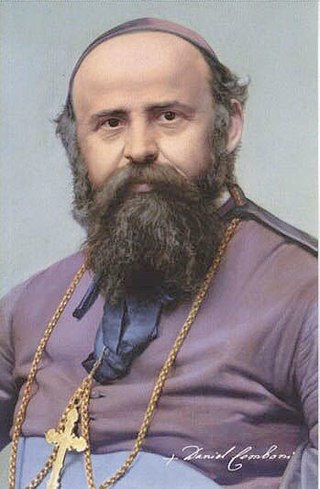
Daniele Comboni, MCCJ was an Italian Catholic prelate who served as Vicar Apostolic of Central Africa from 1877 until his death in 1881. He worked in the missions in Africa and was the founder of both the Comboni Missionaries of the Heart of Jesus and the Comboni Missionary Sisters.

Bishop Enrico Pascal Valtorta was the last Apostolic Vicar and the first Roman Catholic bishop of Hong Kong.

The Catholic Church in Myanmar is part of the worldwide Catholic Church, under the spiritual leadership of the Pope in Rome. In 2020, there were approximately 700,000 Catholics in Burma - approximately 1.29% of the total population.

The Pontifical Institute for Foreign Missions or PIME is a society of secular priests and lay people who dedicate their lives to missionary activities in: Algeria, Bangladesh, Brazil, Cambodia, Cameroon, Chad, Guinea-Bissau, Hong Kong, India, Ivory Coast, Japan, Mexico, Myanmar, Papua New Guinea, Philippines and Thailand.
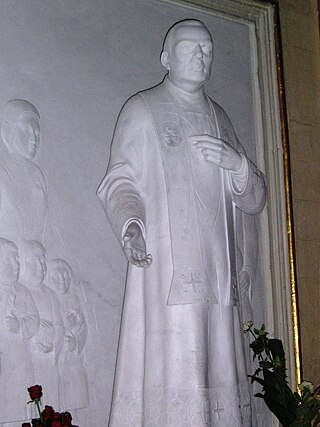
Filippo Smaldone was an Italian Roman Catholic priest and the founder of the Salesian Sisters of the Sacred Hearts. Smaldone is best known for his extensive work with the deaf during his lifetime. Smaldone was a gifted preacher known for his commitment to proper catechesis and to the care of orphans and the mute, which earned him civic recognition.
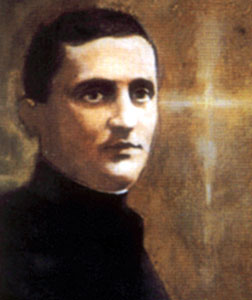
Riccardo Pampuri, OH - born Erminio Filippo Pampuri was an Italian medical doctor and a veteran of World War I who was also a professed member from Hospitallers of Saint John of God. Pampuri worked as a field doctor on the battlefield during the Great War and was discharged in 1920 when he was able to resume his studies and soon begin his own practice as a doctor where he tended to the poor without charge. He became a member of the Third Order of Saint Francis as "Antonio" while founding the Band of Pius X which he dedicated to the medical care of poor people. But Pampuri later became a professed religious for the call was too great for him to ignore; he managed a free dental clinic in Brescia for his order.
Francesco Spoto was an Italian Catholic priest who served in the missions in the Democratic Republic of Congo and was killed there. He was also a professed member from the Missionary Servants of the Poor.

Giovanni Battista Scalabrini, CS was an Italian Catholic missionary who served as Bishop of Piacenza from 1876 until his death. He was the founder of both the Missionaries of Saint Charles and the Mission Sisters of Saint Charles.
Paolo Manna was an Italian Roman Catholic priest and a member from the Pontifical Institute for Foreign Missions as well as the founder of the Pontifical Missionary Union. Manna worked in the missions in Burma and even served as the Superior General for PIME. Manna did much in his life to promote the missions and the evangelic and apostolic zeal that accompanied it and he established newspapers and movements to help promote this charismatic apostolate. He also held several leadership positions in PIME and used that standing in order to further engage with prospective missionaries.
Blessed Father Clement Vismara was an Italian priest and missionary. He is venerated by the Roman Catholic Church. He spent 65 of his 91 years in forests of Burma assisting Akhà and Ikò tribal peoples, particularly children and widows.
Giuseppe Ambrosoli was an Italian Catholic priest and professed member from the Comboni Missionaries of the Heart of Jesus. He served as a doctor and surgeon as well as being a philanthropist and educator in the missions in Uganda. Ambrosoli studied before World War II when he once risked his life to smuggle Jewish people into Switzerland before returning home to finish his studies in medicine prior to commencing his ecclesial studies. He joined the Comboni missionaries and was sent to Uganda where he became known as the "saint doctor" for his loving and compassionate treatment of all ill people whom he dedicated himself to.

Rudolf Komórek was a Polish priest and a professed member of the Salesians of Don Bosco while also serving as part of the missions in Brazil. He served during World War I as a hospital chaplain and began the process of joining the order of Saint John Bosco following his time as a prisoner of war in Trento.

The Martyrs of Laos are seventeen Catholic priests and professed religious as well as one lay young man venerated as martyrs killed in Laos between 1954 and 1970 of the First and Second Indochina Wars during a period of anti-religious sentiment under the Pathet Lao Theravada Buddhist-communist political movement.

Marcello Candia was an Italian Roman Catholic industrialist and entrepreneur who became active in the missions in Brazil. He worked to protect Jewish people during World War II and was involved in preventing their deportation by the creation of new documents that would save the Italian Jews' lives by making pass them as non-Jewish Italians, in particular for kids by hiding them in homes and industries or helping them to safety relocate to the UK or America.
In 1950, at his father's death and at the end of WWII, Marcello Candia assumed full management of his family chemical industrial factory headquartered in Milan with full control of its operation across Italy. After experiencing the world devastation of WWII, Marcello developed a deep awareness for the plight of the poor people, concern that prompted him to sell his factory in 1964 and moved to Brazil to assist the people in need living in the Amazons. In Brazil he worked for the needs of the poor, supporting social justice initiatives and the work of the local charities. Candia was subject to suspicion in the beginning from those missionaries who were confused at someone from a rich background coming to serve the poor as a poor man. He shrugged off those suspicions and considered himself a disciple of the poor who wished to alleviate their suffering and social conditions.
Alfredo Cremonesi was an Italian Roman Catholic priest of the Pontifical Institute for Foreign Missions. He studied in Crema and Milan before setting off from Genoa to Naples and then to the Burmese missions via boat. He pledged that he would never return to the Italian mainland and spent the remainder of his life working with the Burmese people in mountain villages despite the great difficulties he faced. Cremonesi was also a prisoner of the Japanese during World War II after the Japanese occupied the nation.

Francesco Convertini, SDB was an Italian Catholic priest and member of the Salesians of Don Bosco. He served in the missions in India since arriving there in the mid-1920s and dedicated his apostolate to tending to children suffering from malnutrition and fostering interreligious dialogue and tolerance. He also dedicated himself to preserving the environmental protection of local communities in waste-ridden areas and travelled to various communities to bring forth the Gospel message to all people.
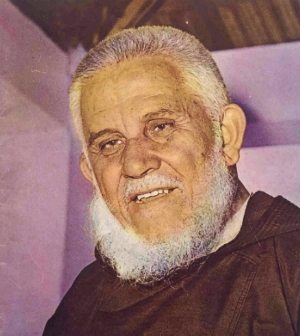
Damião de BozzanoO.F.M. Cap., born as Pio Giannotti, was an Italian Roman Catholic priest and a professed member from the Order of Friars Minor Capuchin who served in the Brazilian missions for over six decades. Giannotti entered the order when he was twelve to do his ecclesial studies and religious formation of which he spent some of that time in Rome. He worked as a teacher from 1928 until 1931 when he was sent to the missions in Brazil. He would remain there for the rest of his life and would go travelling often to northern Brazilian cities where he would celebrate Mass and evangelize while hearing confessions on a frequent basis.
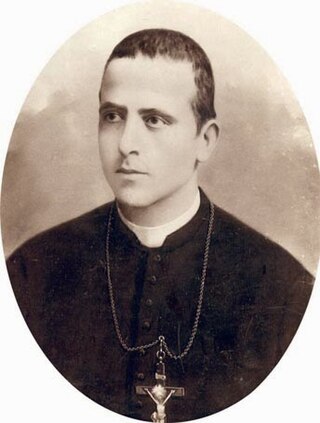
Giuseppe Marchetti was an Italian Roman Catholic priest from the Missionaries of Saint Charles Borromeo and the co-founder of the Sisters Missionaries of Saint Charles Borrome; and from the beatification process, titled as a Venerable. Marchetti served first as a local pastor after his ordination but decided to later help Giovanni Battista Scalabrini in his mission to tend to and support Italian emigrants. He started to take trips to Brazil to focus on Italians relocating there and later moved there to found an orphanage and to work alongside abandoned children and emigrants. He also invited his sister, Assunta Marchetti, to help him in his work and she would continue his mission for the four decades after his death. She herself would become beatified, as a Blessed Mother.
Lorenzo Maria Balconi was an Italian archbishop of the Catholic Church, missionary, and writer.

Pedro Ortiz de Zárate was an Argentine Roman Catholic priest and Giovanni Antonio Solinas was an Italian Roman Catholic priest and a professed member of the Society of Jesus. Zárate served in a local municipal role before he was married and had two children. He was widowed and decided to enter the priesthood once his two sons were old enough to handle the change; he was a noted preacher and envisioned himself as one that would convert and preach amongst the local Argentine native tribes. Solinas left for the Argentine missions alongside three companions and moved from place to place before he settled in the Salta province. Both priests were slain after two tribes of natives decided to deceive them to preach and work in their village before ambushing and killing both priests; eighteen others were slain alongside them and their bodies left to be discovered as the assailants fled in fear of Spanish forces that were not too far from their position.
References
- 1 2 3 4 5 6 7 8 9 10 "Pope: Pimino "God's blacksmith", happy by name and nature, on path towards sainthood". Asia News. 12 June 2019. Retrieved 14 June 2019.
- 1 2 3 4 5 6 Fr. Giovanni Musi P.I.M.E. (22 January 2018). "Servant of God". PIME Missionaries USA. Archived from the original on 2 November 2019. Retrieved 14 June 2019.
- 1 2 3 4 5 6 7 8 9 10 11 "The Story of A Happy Missionary". PIME Missionaries USA. 15 January 2018. Archived from the original on 2 November 2019. Retrieved 14 June 2019.
- 1 2 3 "Venerabile Felice Tantardini". Santi e Beati. Retrieved 14 June 2019.
- ↑ "Causa Tantardini pubblicata la relazione finale del congress teologico". Pontifical Institute for Foreign Missions. 11 February 2019. Archived from the original on 2 November 2019. Retrieved 14 June 2019.